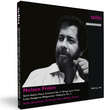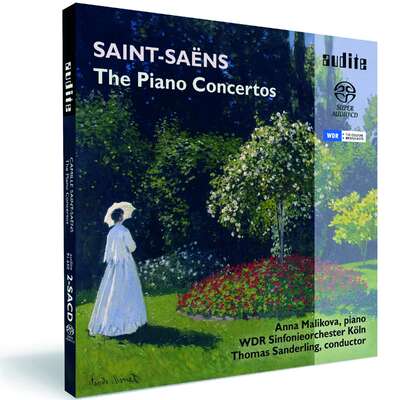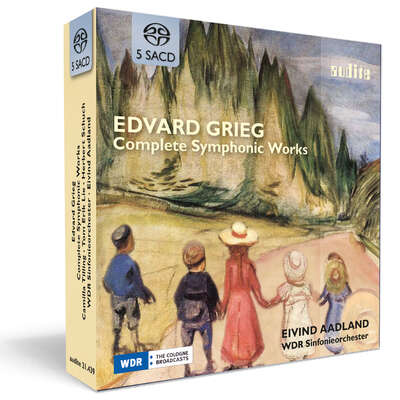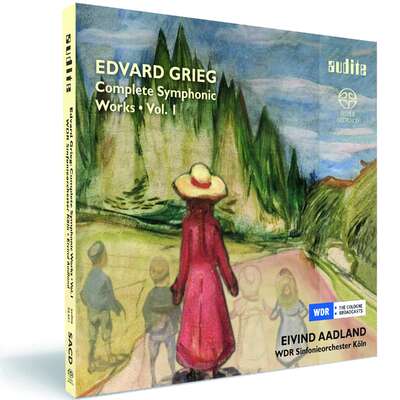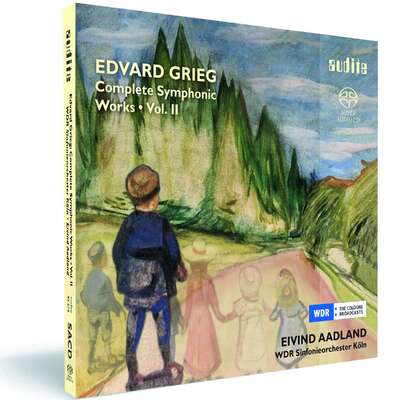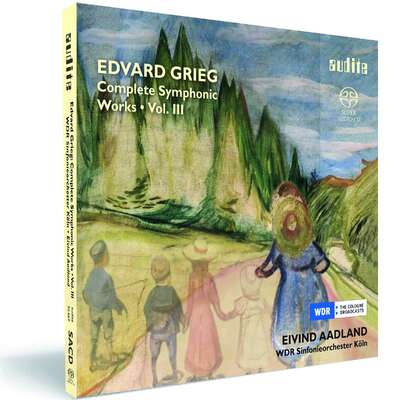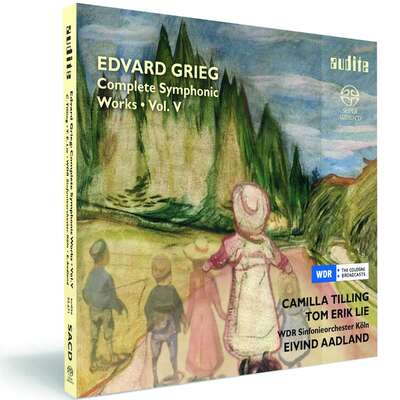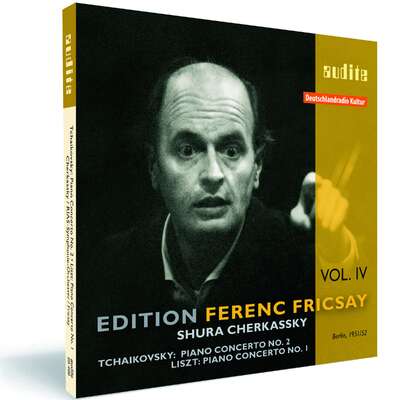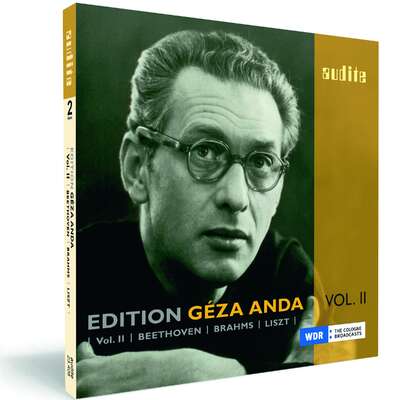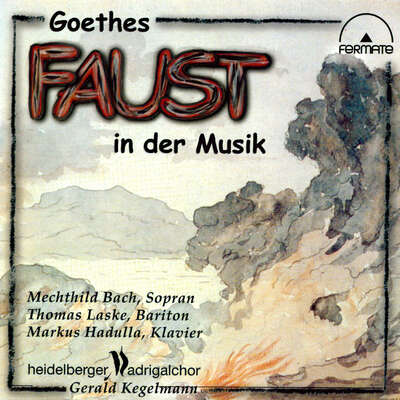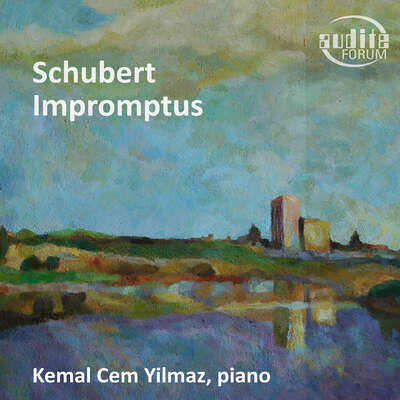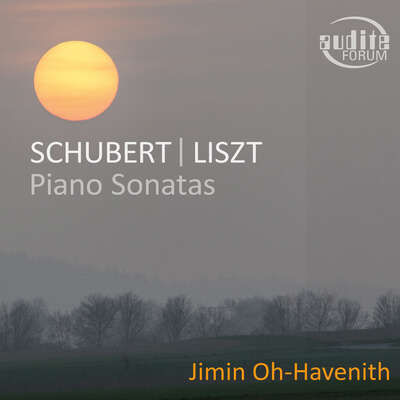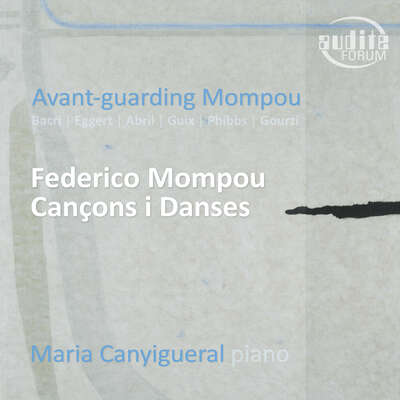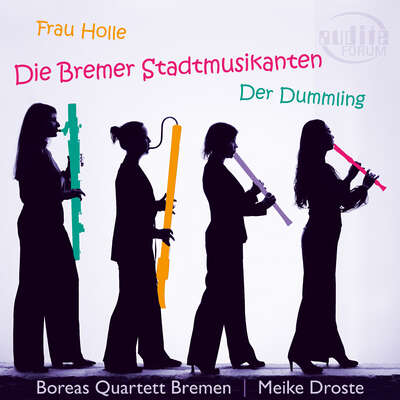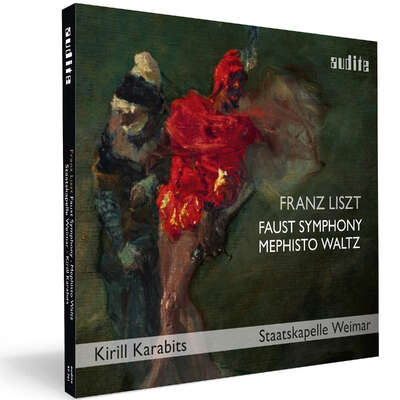
Nelson Freire – technische Souveränität mit augenzwinkernder Gelassenheit: Saint-Saëns’ Zweites Klavierkonzert und das deutsche Radio-Debüt mit Grieg und Liszt in bislang unveröffentlichten Aufnahmen.mehr
"Es gelingen ihm subtilste Nuancen und feinste Differenzierung, anfangs sogar tiefe Besinnlichkeit und Melancholie. […] Freires Finger huschen flink über die Tasten und lassen die Musik zum funkelnden Feuerwerk werden." (Pizzicato)
Details
| Nelson Freire plays Saint-Saëns, Grieg and Liszt | |
| Artikelnummer: | 95.742 |
|---|---|
| EAN-Code: | 4022143957429 |
| Preisgruppe: | BCB |
| Veröffentlichungsdatum: | 11. August 2017 |
| Spielzeit: | 55 min. |
Zusatzmaterial
Informationen
Saint-Saëns' Zweites Klavierkonzert mit Nelson Freire unter dem Dirigat von Ádám Fischer: Nur wenigen Pianisten ist es möglich, die stilistischen und technischen Anforderungen dieses Konzerts, das an Grifftechnik, Sprungsicherheit und „jeu perlé" alles abverlangt, mit einer solchen Souveränität und (manchmal augenzwinkernden) Gelassenheit zu meistern wie Nelson Freire. Er musiziert mit vollem Risiko und Engagement, entfacht regelrechten „Sturm und Drang", immer kongenial begleitet von Ádám Fischer.
20 Jahre zuvor hatte der brasilianische Ausnahmepianist als 22-Jähriger bereits sein Debüt im deutschen Radio gegeben - mit einem Recitalprogramm, das er im Studio Lankwitz des RIAS Berlin einspielte. In Griegs Lyrischen Stücken und den Ungarischen Rhapsodien Nr. 5 und 10 von Liszt sowie seiner zweiten Polonaise E-Dur zeigte Freire nicht nur seine stupenden manuellen Fähigkeiten, sondern auch seine schon damals außerordentliche Anschlagskultur und Stilsicherheit. Diese frühen Einspielungen der Solowerke weisen voraus auf die spätere, brillante Entwicklung und komplettieren das Bild des außergewöhnlichen Pianisten.
Alle Aufnahmen werden hier erstmals veröffentlicht.
Besprechungen
Piano News | Mai/Juni 3/2018 | Carsten Dürer | 1. Mai 2018
Alte Aufnahmen
Von der britischen Insel über Salzburg und die USA nach Berlin
[Freire] nimmt keine Phrase von Grieg als gegeben einfach und simpel hin, sondern füllt sie mit klanglicher Ausarbeitung so mit Leben, dass jedes dieser Stücke eine eigene Welt bedeutet, wenn man sie in seiner Darstellung anhört. Mehr lesen
American Record Guide | January / February 2018 | Donald R Vroon | 1. Januar 2018 | Quelle: http://argsubson...
I am especially fond of the second Saint-Saens concerto, and I have heard it a number of times in concert. I have five or six recordings of it, and IMehr lesen
But the concerto is 23 minutes. The rest of the time here is a recital by the pianist. Yes, he plays it all quite beautifully, as one expects of him. But you need at least a full CD of Grieg Lyric Pieces, not just these five (10 minutes). And you need a set of Hungarian Rhapsodies, not just these two—not two of my favorites, either!
So if you already have the concerto, you would buy this only for the pianist. The sound is excellent. The recordings are from 1986 (concerto) and 1966.
Fanfare | December 2017 | Huntley Dent | 1. Dezember 2017 | Quelle: http://www.fanfa...
This worthy addition to the discography of Nelson Freire captures one of a handful of live concerto recordings to be found outside his major-labelMehr lesen
What immediately attracts major pianists to the Saint-Saëns Second is the gesture of placing a cadenza-like prelude before the orchestra enters, a twist on a Bach organ prelude, and as in Bach (or Beethoven’s Choral Fantasy, which uses the same gesture) the music is free-form, improvisatory, and expressive. Freire takes a large-scaled Romantic view of the introduction, setting the mood for a reading of the first movement strong in passion and virtuosity. Ádám Fischer’s conducting follows suit, although he’s fairly ordinary in comparison to such a charismatic soloist. Taking Jean-Yves Thibaudet and Charles Dutoit (Decca) as a good modern standard, Freire is just as sparkling in the Scherzo but more virtuosic in the finale, where Fischer also catches fire. It would get no argument from me if someone called his reading a first choice. (Equally exciting concerto performances can be found in Decca’s two-CD collection of the pianist’s radio broadcasts, which I welcomed enthusiastically in Fanfare 38:4.)
Since there was no online booklet, I can’t say why the Liszt and Grieg pieces, being studio recordings, didn’t make it to disc previously; I presume this was a radio broadcast. In any event, the recorded sound, if a bit dry and confined, is perfectly respectable. In his selection of five of Grieg’s 66 Lyric Pieces, Freire is so convincing that one longs for more. Charisma isn’t what these homey pieces call for, being chiefly aimed at the Victorian market for amateur-level character pieces. Freire brings the sensitivity of a great Chopinist to meditative miniatures such as “Lonely Wanderer” and imparts a touch of brilliance where he can, as in “Little Birds.” The only other pianist I know who found such modest magic was Walter Gieseking in his monaural collection for EMI.
Liszt is more familiar territory for Freire, whose Decca album for the composer’s bicentennial was one of the high spots among a slew of solo recitals that year; he has also recorded the B-Minor Sonata, Totentanz, and both concertos. The three works on the present release are fairly offbeat. The two Hungarian Rhapsodies, No. 5 and No. 10, are generally found only in complete cycles—neither was recorded by Horowitz or Richter, and Grigory Ginzburg has only a single recording of No. 10, just to name my favorite Lisztians. Freire gives No. 5 a dignified, stately reading suitable to its solemnity. No. 10 is far more a showpiece, like the famous No. 2, and here Freire shines with effortless passagework and trills while avoiding any hint of vulgarity. He succeeds in finding the music behind the cascade of notes, in the vein of Alfred Brendel’s Liszt but with more warmth. Polonaise No. 2 is as heroic and showy as Chopin’s most forceful examples, so I’m surprised that I didn’t know the piece already. It’s like Chopin with bells and whistles added, an exciting final flourish to the program. Richter has been captured in this work no less than 15 times (!), the vast majority on tour in 1988; I should have been paying much better attention. Freire plays at the same level of bravura.
Everything about this release is superb. In the current issue I review Freire’s new release of Brahms solo piano works, also new to his discography, so it’s a month to celebrate for those who esteem his art.
BBC Music Magazine | November 2017 | Claire Jackson | 1. November 2017
Nostalgia is a heady temptation, but newly released historic recordings such as Nelson Freire's brilliant concert performance of Saint-Saens's SecondMehr lesen
Gramophone | October 2017 | Harriet Smith | 1. Oktober 2017
Nelson Freire hasn’t made a commercial recording of SaintSaëns’s Second Piano Concerto, which makes this radio recording from 1986 all the moreMehr lesen
The solo pieces on this disc were recorded when Freire was only 21 and have not been previously released. How good it is to have a selection of Grieg’s Lyric Pieces, which are vividly rendered. If the ‘Solitary traveller’ (Op 43 No 2) is still more forlorn in Stephen Hough’s hands, Freire’s ‘Little bird’ (Op 43 No 4) is set free by the lightest of pedalling and a scampering virtuosity (Andsnes is more sustained – both are compelling). The colourful ‘Norwegian Melody’ (Op 12 No 6) moves from stamping rhythms to a darting, shifting idea, though Andsnes is arguably even more effective here, making more of its folkish qualities at a faster tempo. Freire’s ‘Shepherd Boy’ (Op 54 No 1) is a highlight, conjuring a palpable sense of loneliness, of vast unpeopled vistas.
Freire’s Liszt has always had a nobility to it and the pieces here are no exception. If he can’t quite match the darkness of Cherkassky (c1946) in the Fifth Hungarian Rhapsody – a searing reading whose sense of purpose glows through the crackle of the recording – it is still remarkable for its gravity, while the 10th is entirely without garish showmanship, Freire’s panache with its glissandos a joy to behold. In the Second Polonaise, too, we find muscularity and finesse in perfect balance. A fine addition to the Freire discography.
Crescendo Magazine | Le 19 septembre 2017 | Ayrton Desimpelaere | 19. September 2017 | Quelle: http://www.cresc... Nelson Freire : la noblesse du piano
De la belle musique par un grand monsieur du piano, à écouter et réécouter !Mehr lesen
deropernfreund.de | 4.9.2017 | Egon Bezold | 4. September 2017 | Quelle: http://www.derop... Publikumswirksames Virtuosenfutter
Er produziere so viel wie Äpfel vom Baum fielen, befand einst Camille Saint-Saens höchst persönlich. Und seine Kritiker witzelten über derleiMehr lesen
Mit einem richtigen virtuosen Knüller stellte sich Nelson Freire als ein Meister subtiler Anschlagskultur und fabelhafter Treffsicherheit vor. Der Flügel tönt klar, rund und „würzig“.
Leichtfüßig flitzen die Geistesblitze durch den sommernächtlichen Scherzo-Spuk des zweiten Satzes, der mit prickelnden solistischen Tupfern und wirbeligen Schlagabtausch mit den Bläsern besondere Reize bietet. Und welche Hatz im Presto-Finale wenn Freire den quecksilbrigen Tarantella-Rhythmus im Stil einer schmissigen Offenbachiade den Zuhörern in die Ohren zaubert. Dass Saint-Saens auch in den nachdenklichen Passagen kein Kaminträumer ist, macht der Solist mit seinem klangvollen unparfümierten Klavierspiel deutlich. Dem Radio-Symphonie-Orchester Berlin (jetzt Deutsches Symphonie-Orchester Berlin) geraten allerdings mit Adam Fischer am Pult die begleitenden Kommentare ein wenig pausbäckig.
Schließlich entführt Nelson Freire in die Miniaturwelt der „Lyrischen Stücke“ von Edvard Grieg, die der Komponist mit Elementen der Volksmusik aus seiner Heimat verschmolz wie leere Quinten, prägnant akzentuierten Tanzrhythmen und satztechnischen Konstellationen der Spätromantik, die harmonisch teilweise den Impressionismus antizipieren. Der vor allem bürgerlich orientierte hausmusikalische Duktus, das unverkennbare aufdringliche Gepräge, ist Griegs Sache wohl nicht. So erweist sich „Der einsame Wanderer“ als ein melancholiches Selbstporträt, während das „Vöglein“ einen Vorschein impressionistischer Klangwelt spiegelt. Formale Konturen verwischt der „Hirtenknabe“.
Höchste solistische Anforderungen stellen die Oktav- und Glissando-Ketten der 10. Rhapsodie von Franz Liszt dar, die dem Komponist zur Erweiterung der Ausdrucksfähigkeit dient. Die 5. Rhapsodie e-Moll wird mit dem Namen „Heroide-elegiaque“ dekoriert und nimmt innerhalb des bedeutenden Klavierwerks von Franz Liszt eine Sonderstellung ein. Spieltechnisch funktioniert alles perfekt. Staunenswert ist die durchdringende Kraft und mit Düsternis umrankte 1852 publizierte Polonaise Nr. 2 in e-Moll. Nichts wird hier mit Sentimentalität beschwert. Bei aller Freude an den instrumentalen Pointen kommen auch feinädrig gezogene kammermusikalisch intime Abschnitte zur Geltung. In eleganter Ausdruckshaltung, im Wechsel von leidenschaftlichen Attacken und rasant abzischenden Figurenwerk beweist Nelson Freire respektgebietende pianistische Souveränität.
Record Geijutsu | SEP.2017 | 1. September 2017
Japanische Rezension siehe PDF!Mehr lesen
Stereoplay | 9|2017 | Attila Csampai | 1. September 2017 Brasilianer in Berlin
Jetzt hat das Detmolder Label audite, das für seine historische Serie Rundfunkarchive auswertet, im RIAS-Katalog einen bislang unveröffentlichten Berliner Livemitschnitt Freires aus dem Jahr 1986 entdeckt, in dem er das bis heute unterschätzte zweite Klavierkonzert von Camille Saint-Saens mit vulkanischer Energie auflädt und es als höchst originelles Meisterwerk der Gattung rehabilitiert, zu einer Zeit, als man es außerhalb Frankreichs kaum spielte. Dirigent Adam Fischer und das RSO Berlin ließen sich damals förmlich mitreißen von der explosiven Vitalität und den rasenden Tempi des 41-jährigen Energiebündels Freire. Mehr lesen
Audiophile Audition | August 28, 2017 | Gary Lemco | 28. August 2017 | Quelle: http://www.audau...
The colossal panache and sweep of this performance will doubtless motivate Freire acolytes to demand more heated excursions into this pianistic, luxurious world.Mehr lesen
www.myclassicalnotes.com | August 18, 2017 | 18. August 2017 | Quelle: http://www.mycla... Nelson Freire performs Grieg
Freire not only demonstrated his pianistic skills, but also what was already at that stage his extraordinary touch and stylistic confidence.Mehr lesen
www.pizzicato.lu | 11/08/2017 | Remy Franck | 11. August 2017 | Quelle: https://www.pizz... Nelson Freire: Neues von 1966 und 1986
Diese CD mit Archivaufnahmen von 1966 und 1986 enthält ausschließlich Erstveröffentlichungen. Die Wiedergabe des Zweiten Klavierkonzerts vonMehr lesen
20 Jahre zuvor hatte der brasilianische Pianist als 22-Jähriger für den RIAS Berlin fünf von Griegs Lyrischen Stücken, Liszts Ungarische Rhapsodien Nr. 5 und 10 sowie seine zweite Polonaise eingespielt. Die Grieg-Stücke sind reichlich nüchtern geraten, aber die drei Liszt Werke zeigen Freire als inspirierten Interpreten, der das Rhapsodische der Werke mit viel tiefer Versenkung wiedergibt.
With a reflective und finely nuanced first movement, a sparkling Allegro scherzando and a volatile Presto, Nelson Freire’s account of the Second Saint-Saëns Concerto is mesmerizing. In the solo recordings from 1966 the Grieg is less compelling, but the Liszt compositions show him as a very inspired performer.
